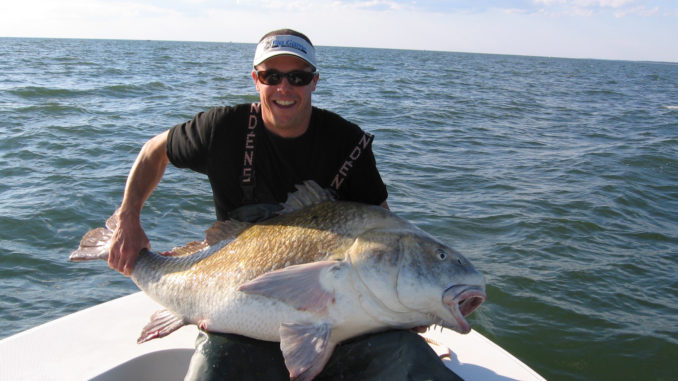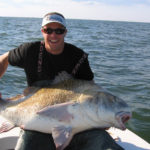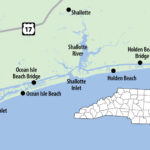
Fish the low end of the tide with pieces of shrimp and harvest a crop of winter black drum.
February is the coldest month, and most North Carolina fishermen are either dreaming on the couch or gliding stealthily across a narrow lens of saltwater with a school of red drum in their sights.
But red drum and shallow water are not the only options. This month, the other saltwater drum, the black drum — the one with the black and white stripes — is plentiful, and anglers can easily access these wintering fish with a vessel of almost any size in the waters of lower Brunswick County waters, within earshot of the Atlantic Ocean’s breaking waves.
Compared to the rest of the year, the inshore haunts appear to become barren wastelands; most of the baitfish and shrimp are long gone. However, a few inshore favorites, including speckled trout, red drum and black drum, are somewhat tolerant of cold weather, and decent populations of these fish will overwinter in the heart of inshore waters.
In fact, black drum are at home in the brackish estuaries. Considered among the most-adaptable fish, with the ability to live just about anywhere, the cold weather doesn’t adversely affect them the way it does many other species. When minnows, shrimp and crabs either leave or bury down in the mud, most other predator fishes are at a loss, but not black drum. They eat oysters, crushing and chewing them with their strong teeth, which happens to be one reason why anglers find concentrations of them around oyster-encrusted structures.
Capt. Mark Stacy of Ocean Isle Fishing Charters catches plenty of black drum over the winter, and structure for him is very important.
“Oyster banks, dock pilings and any kind of structure can have black drum during the cool months,” Stacy said. “The high-rise highway bridges are also good places to find blacks in winter because of the deep water.”
Black drum relate strongly to structure because any food that may be around will be around some type of structure, and Stacy concentrates on what he can find in the Intracoastal Waterway. Even though black drum are tolerant of cold water, they are still fish. They will seek out temperature stable and warmer places when available.
“The ICW is deep and a lot of good structure is available with deep water for black drum,” he said.
Capt. Kyle Hughes of Speckulator Fishing Charters fishes out of a bay boat that’s perfect for the deeper places along the ICW during the winter.
“Water at depth will be warmer, and crabs will bury up in the mud at the bottom of these deep holes along the ICW,” said Hughes (910-840-7186). “They can also hide from porpoises around docks.”
Since baitfish are gone, marine mammals have very little to eat, and that makes redfish, speckled trout and black drum perfect candidates for snacking.
Hughes looks for docks and structure in the deeper places.
“Docks with 4 to 5 feet of water at low tide are ideal, and the older docks with more growth are the best,” says Hughes.
Similar to red drum, fishing for black drum is best on either side of the low tide. Stacy and Hughes prefer periods with consistent current.
Since black drum are very adaptable, they may not stay in one place throughout the season. The ICW is peppered with docks, marinas, bridges and other types of structure that will be covered with barnacles and oysters.
Stacy will not stay in one place very long when looking for a school of fish.
“Black drum are schooling fish this time of year, and if you catch one, you will catch more. I will pull up to a dock and fish for 15 to 20 minutes. If I don’t get bit, I will move to another spot,” he said.
However, Stacy urges anglers to always check places where they have caught black drum in the past, because they will frequent some of the same places when conditions are favorable.
Stacy often finds schools of black drum while venturing up tidal creeks on low tide to find a big school of wintering reds.
“They will be in the deeper pools of shallow creeks that are usually 3 to 4 feet deep. They will be just about everywhere from the top of the creek to the mouth,” he said. “Check all of the pools and the indentations along the oyster banks.”
With little to eat, black drum can display a fierce appetite, especially during a period of unseasonably warm weather. Just a few degrees can make a huge difference and produce an aggressive bite for anglers looking for winter action.
Black drum have a wide range of dietary options, and just about any bait will put fish in the boat. However, black drum find food with the receptors at the ends of their chin barbells. Fresh chunks of crab, shrimp and oysters are ideal baits, with shrimp usually the most-available, most-affordable and easiest to thread on a small hook.
Stacy and Hughes will shrimp from either the seafood market or from shrimp they caught during the fall in cast nets. But all shrimp and bait is not created equal.
“Frozen shrimp is okay, but fresh shrimp is the best, cut into small pieces,” Stacy said.
A small chunk of bait is all that is needed. Black drum can pick up the scent of bait from long distances, and a smaller piece of bait will insure that the hook makes its way into the fish’s mouth.
Hooks sizes 1/0 or smaller are preferred, fished with just enough weight to anchor the bait on the bottom. Anglers can use split shot, a Carolina rig, or a ¼-ounce jighead.
While natural bait is preferred, certain artificial options can produce fish. Lures need to be soft and scented to trigger a bite. Gulp! baits are a proven commodity with it comes to red drum and black drum, and the smaller, 2- to 3-inch shrimp or swimming mullet are preferred.
Spray attractants on traditional small, soft plastics will also produce good bites in winter, especially if they’re in crab or shrimp flavors.
February can be a tough time to be on the water, but an action-packed day on the water regularly fighting black drum can get the blood flowing enough to warm anglers from head to toe. And even though the water is cold, black drum are not sissies. They will put up a good battle that will satisfy any anygler, leaving him wanting more.
DESTINATION INFORMATION
WHERE TO GO/HOW TO GET THERE — The waters in the southern half of Brunswick County, including Ocean Isle Beach and Holden Beach are easily accessed from public boat ramps located at the base of bridges that connect the mainland to Sunset Beach, Ocean Isle Beach and Holden Beach. Visit http://ncpaws.org/wrcmapbook/baa.aspx. Look in deeper areas along the ICW and feeder creeks, especially where oysters and barnacles are available on structure.
WHEN TO GO — Fishing for black drum is best from November through April. Black drum are most active with the water temperature between the upper 40s and lower 50s. Best fishing will be in the middle of the day when the sun has warmed waters to their daily peak. A mid-day or early afternoon low tide is best; fish two hours on either side of dead low.
BEST TECHNIQUES — Small pieces of shrimp fished on the bottom using small hooks and a split-shot or Carolina rig, or on a jighead or under a float. Scented soft-plastic lures will also attract black drum, which locate food largely by scent. Fish slowly with 7-foot, medium to medium-heavy spinning rods and reels spooled with 14- to 20-pound braided line.
FISHING INFO/GUIDES — Capt. Kyle Hughes, Speckulator Inshore Fishing Charters, 910-840-7186, www.oceanislefishingguide.com; Capt Mark Stacy, Ocean Isle Fishing Charters, 910-279-0019, www.oceanislefishingcharters.com. See also Guides and Charters in Classifieds.
ACCOMMODATIONS — Causeway Inn, Ocean Isle Beach, 910-579-0743; Elliott Realty 888-669-7853 (rentals); Brunswick County Vacation Guide, 910-755-5517, www.ncbrunswick.com; Official Travel & Tourism Website for North Carolina, www.visitnc.com.
MAPS — Navionics, www.navionics.com, 800-848-5896; The Good Spots, 800-411-0185, www.thegoodspots.com; Grease Charts www.greasechart.com (AC 002-A: Long Bay-Cape Fear).






